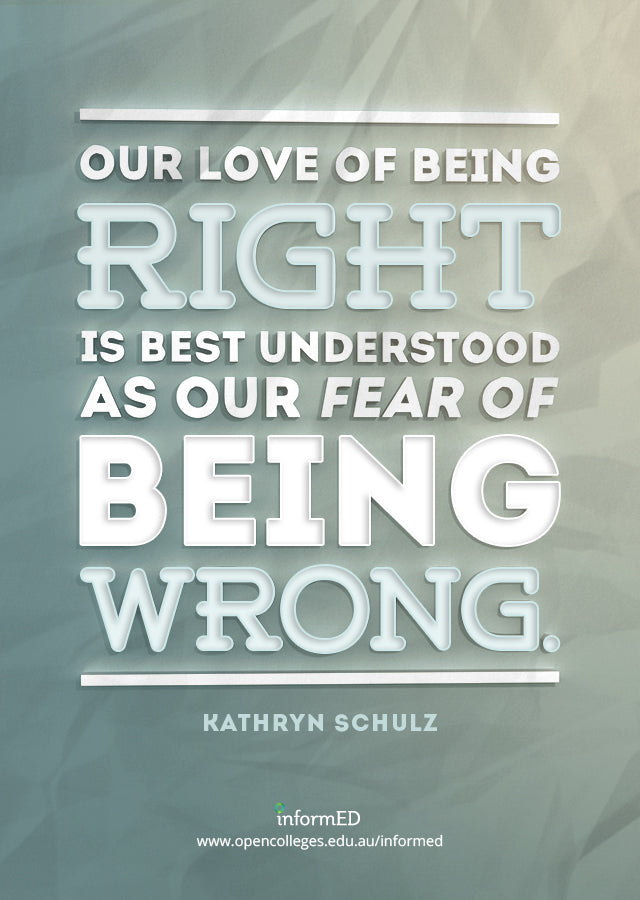Explore our collection of informative and educational blog posts to stay updated on the latest industry trends and expert advice.
Overcoming the Fear of Being Wrong: 20 Ways To Help Your Students

Like cheating on a test, ignoring a friend’s phone call, wallowing in self-pity, or eating a pint of ice cream in one sitting, being wrong feels the worst when someone else is around to witness it. Unlike these things, being wrong is unjustly stigmatized as unacceptable. Everyone answers a question incorrectly now and then, but it’s the shame associated with being wrong, especially in front of others, that harms us more than the fault itself.
Disappointment is a natural feeling, and more often than not drives resilience and determination. But in today’s society, making the wrong decision or giving the wrong answer is associated with embarrassment, ridicule, and reduced self-worth. Even not knowing is better than being mistaken. You could drain every human brain on the planet and leave a chorus of robots chanting, “I don’t know,” and that would be better than animated beings expressing themselves colorfully, creatively, even eloquently—but falsely.
I’m sure many a theory could be suggested on why and how this stigma exists, but let’s not concern ourselves with the past. What’s important is why overcoming the fear of being wrong is a good thing, and how we can go about correcting our present attitude.
In the classroom, there are two things immediately and dramatically affected by the fear of being wrong: freedom of expression and creativity.
For fear of being wrong, many students never participate in class or ask questions. This has several negative effects on learning: 1) Because classroom environments are designed to let students learn not only from the teacher but from each other, the potential benefits of a shared learning environment are lost; 2) Because students oftentimes are wrong but are too afraid to ask questions, they never learn the right answer; 3) Because students oftentimes are right, but doubt themselves too much to volunteer, they miss out on a potentially rewarding experience.
For fear of being wrong, or simply being judged by their peers, students limit their creativity. Playing it safe and erring on the side of conformity may reduce your students’ chance of rejection, but it will also reduce their chance of learning, growing, and contributing something unique to society. As Ken Robinson said, “If you’re not prepared to be wrong, you’ll never come up with anything original.”
Teachers suffer from the stigma as well. When it comes to trying something new in the classroom or offering a radical idea in the conference room, we have all been gripped by the fear of being wrong. But for the very same reasons students must overcome the fear, so must educators.
[Read more about The Value of Mistakes: Should it Matter How Long a Student Takes To Learn?]
Here are a few ways you can help students—and yourself— be a little braver:
- Avoid the Fundamental Attribution Error. One of the most popular concepts in basic psychology, the Fundamental Attribution Error is the mistake people make when they attribute the cause of an outcome to a person instead of a situation. We do this to ourselves all the time, too: “I didn’t get an ‘A’ on the math test because I am bad at math” instead of “I didn’t get an ‘A’ on the math test because I didn’t study fractions hard enough.”
- Learning has two definitions, and one is failure. We use the same word, “learn,” to describe a situation in which you receive new information and a situation in which you update that information. When a high school student hears a lecture on the World Wars, he gathers new information. When he fails his mid-term test because he thought Franz Ferdinand was assassinated at the start of World War II, he corrects that information. Filling your brain with facts is a natural part of learning, and so is realizing you’ve been filling it with bunk.
- Teach a lesson on it. I’m always baffled that these conversations remain in the professional sphere. Communicate this issue with your students. See what they think. Make sure they know what you think about it.
- Always respond to an answer with more than “No.” The best teachers explain why a student’s answer isn’t right, rather than simply telling them it isn’t.
- Look for the “right” in the “wrong.” See if you can recognize traces of the right answer in a wrong answer, and encourage your student to see them too. Was she completely off track, or does she need a little nudge in the right direction?
- Turn wrong answers into a learning experience for all. This is a great way to avoid singling out a student for being wrong. Involve the rest of the class by asking them what they think of the answer given, and encourage them to analyze it. Sometimes the “wrong” answer can lead to an even more interesting discussion than the “right” one.
- Acknowledge students’ thought processes, not just their answers. Answers don’t appear in mid-air. They are arrived at after some thought has been put into a question. Helping a student understand—and correct—his own thought process can be far more beneficial than correcting the answer itself.
- The “wrong” answer is more educational than the “right” answer. This is often the case. I’ve seen so many instances in which the wrong answer actually shed more light on the subject and helped students understand the topic better than when the right answer was offered up front. Express this concept to your students.
- Don’t grade participation. Most teachers include participation as some part (usually 10%) of a student’s overall grade. This is a flawed, outdated system meant to scare students into participating more in class. It hardly ever works. The outspoken students will continue to be outspoken, and the shy students will continue to be shy, unless a culture of mutual respect and an environment free of judgment goes along with it.
- Encourage creativity and innovation. A no-brainer. Indulging students in their creative impulses will demonstrate that you value them, and that students should value them too.
- Remember that everyone is wrong sometimes. Most of the time, we don’t actually witness other people being wrong about something, so, to ourselves, it seems as though we are wrong more frequently than the people around us. In reality, everyone is wrong now and then.
- Stop treating being wrong like an anomaly. Think about this for a moment: Are we correct more often than we are incorrect? Sure, we don’t mistake how to breathe or walk or converse. You remember your mother’s birthday (though you don’t get any credit for knowing the date). But “knowing” is just as often accompanied with “not knowing.” We don’t beat ourselves up for all the things we don’t know (which is a lot), so why should we punish ourselves for being “wrong”? It’s as much a part of our natural state of being as being “right.”
- More often than not, someone else is thinking the same thing. Have you ever had an answer to a question, remained silent, and then listened to someone else give that very same answer? Whether the someone else ended up being right or wrong, the point is you weren’t alone in your thinking.
- Imagine that you’re speaking to a good friend or family member. If you know someone who wouldn’t judge you for asking a certain question, then ask the question.
- Practice doing things outside your comfort zone. This will help you trust yourself and start believing that “putting yourself out there” really doesn’t come with as many risks as you once thought.
- People respect differences more than they resent them. I’ve known so many people who respected me more when I spoke my mind than when I didn’t. Trying to make everyone like you only works in middle school.
- Once you form a habit, it will be easier. Let your students know that, even if they aren’t comfortable speaking their mind or being wrong at first, with time it will become habit.
- Those who matter don’t mind, and those who mind don’t matter. The wise words of Dr. Seuss.
- Adopt an “abundance mentality.” Although it may be a term used largely in business and sales, it applies to education as well: One failure does not mean ultimate failure. There will be many more chances to come.
- The most intelligent people TRY to be wrong on purpose. They’re called scientists. All of human advancement rests upon the principles of scientific investigation, which requires trial and error. The very best scientists try everything they can to prove themselves wrong, because they want their results to be as accurate as possible. Every one of us benefits each time someone is wrong.








